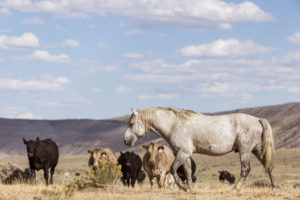For immediate release, August 11, 2021
Media contacts:
Kelly Fuller, Western Watersheds Project, (928)322-8449; kfuller@westernwatersheds.org
Michael Saul, Center for Biological Diversity, (303) 915-8308, msaul@biologicaldiversity.org
Steve Holmer, American Bird Conservancy, (202) 744-6459, sholmer@abcbirds.org
WASHINGTON, D.C. – Yesterday, the Bureau of Land Management (Bureau) announced it is reopening a process to withdraw certain greater sage grouse habitats known as Sagebrush Focal Areas (SFAs) from damaging mining. The proposal would reinstate a process that was started under the 2015 sage grouse Obama-era plan amendments, and which was halted abruptly by the Trump administration in 2017. A lawsuit by conservation groups overturned the Trump-era cancellation, and the courts sent the Bureau back to reconsider whether the withdrawal was necessary for sage grouse conservation.
“The withdrawal is necessary so that sage grouse can survive for future generations to enjoy, but the protected area need to be larger to reflect the increasing threats to this magnificent bird,” said Kelly Fuller, energy and mining campaign director of Western Watersheds Project. “Scientists have recommended protecting all priority sage grouse habitats from all types of mineral extraction disturbance, not just the subset of those areas as proposed in today’s announcement.”
Mining threatens sage grouse by fragmenting and destroying the bird’s habitat, by disturbing soils and facilitating invasive plants and the spread of fire-prone weeds, by draining ground and surface water, as well as by disturbing sage grouse with human activity, including noise. Oil and gas drilling has similar effects, adding much more widespread habitat fragmentation the destroys the ability of sagebrush habitats to sustain sage grouse populations. Sage grouse have strong ‘site fidelity’ and return to the same breeding, nesting, and brood-rearing habitat year after year, even returning to disturbed areas where they can no longer successfully reproduce or survive.
“This is a good first step toward protecting greater sage grouse, but much more is needed to ensure their survival as a species,” said Michael Saul, a senior attorney at the Center for Biological Diversity. “The interlocking challenges of climate change, fire and habitat loss require the Biden administration to take bold action or sage grouse will continue on their current path to extinction. These beautiful birds and their ecosystem won’t recover unless the Interior secretary bans mining and drilling in their priority habitat.”
Recent scientific reports by the U.S. Geological Survey point to continuing population declines with a likelihood for extirpation of local populations, driven by multiple factors degrading sagebrush habitats.
“Protecting large, unfragmented tracts of key sage grouse habitat, not just from mining but from oil and gas drilling and other industrial uses as well, could make sage grouse conservation a cornerstone of the Biden administration’s America the Beautiful initiative to protect 30 percent of America’s land area for biodiversity conservation by 2030,” added Steve Holmer, Vice President of Policy for American Bird Conservancy.
###






